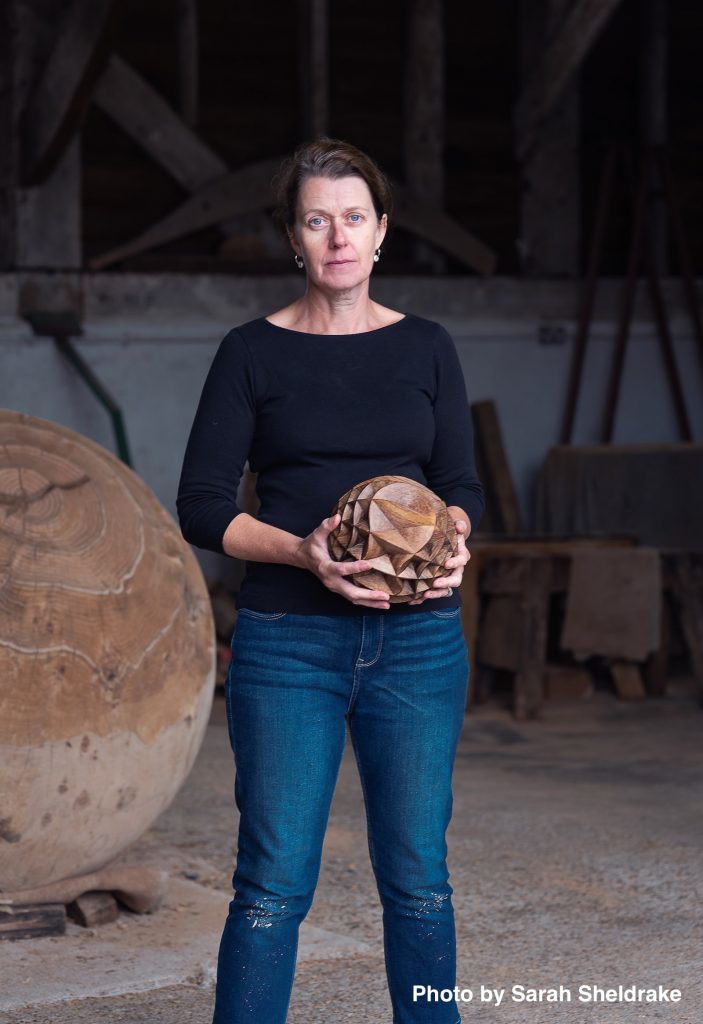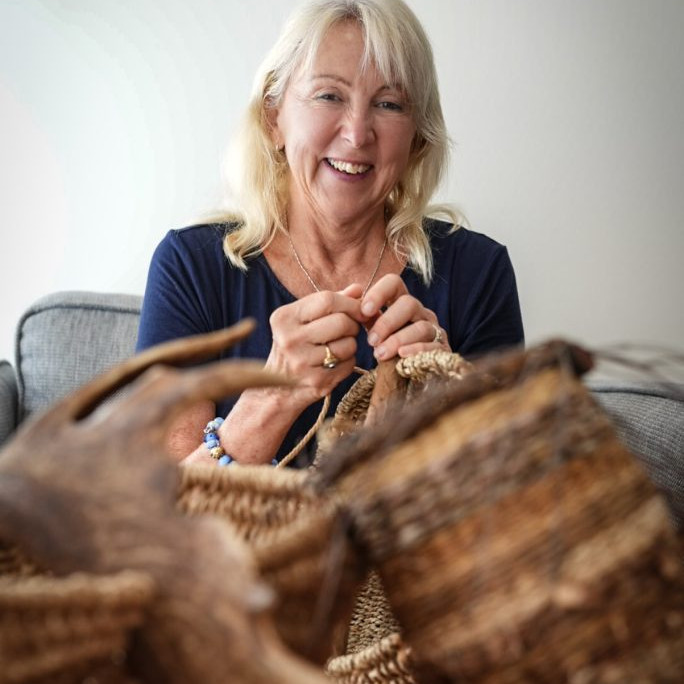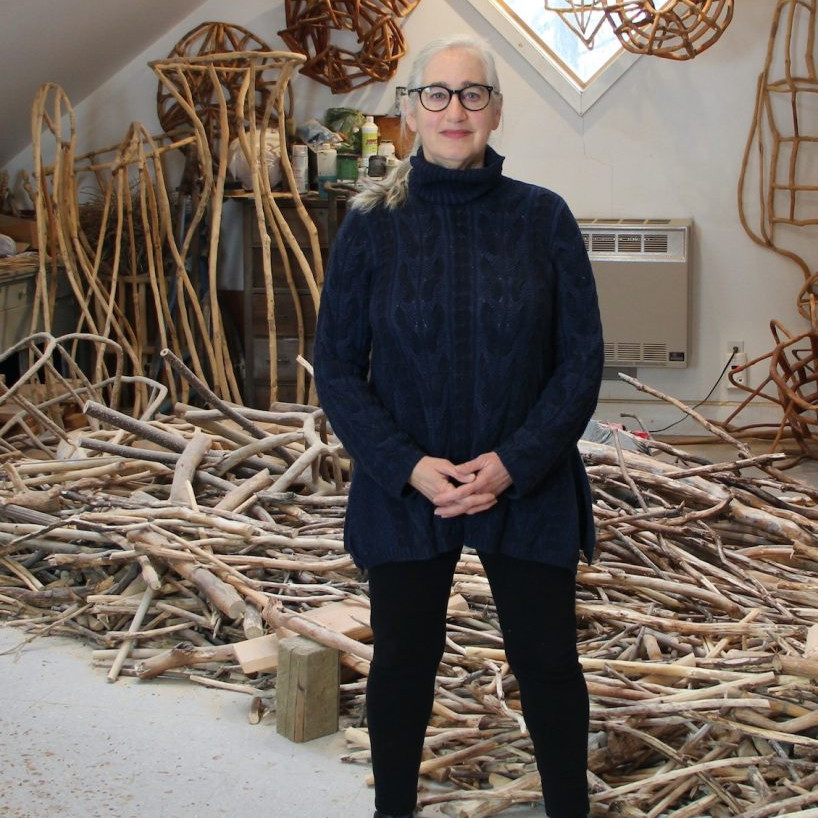Alison Crowther Wood Artist
Can you explain how you came to be working with wood, especially at such a large scale?
I started working with wood whilst doing my first degree in Three-Dimensional Design. I did some research in to the ancient timber-framed houses in West Wycombe, Buckinghamshire and fell in love with oak. The scale has grown with experience and opportunity to use whole trees.
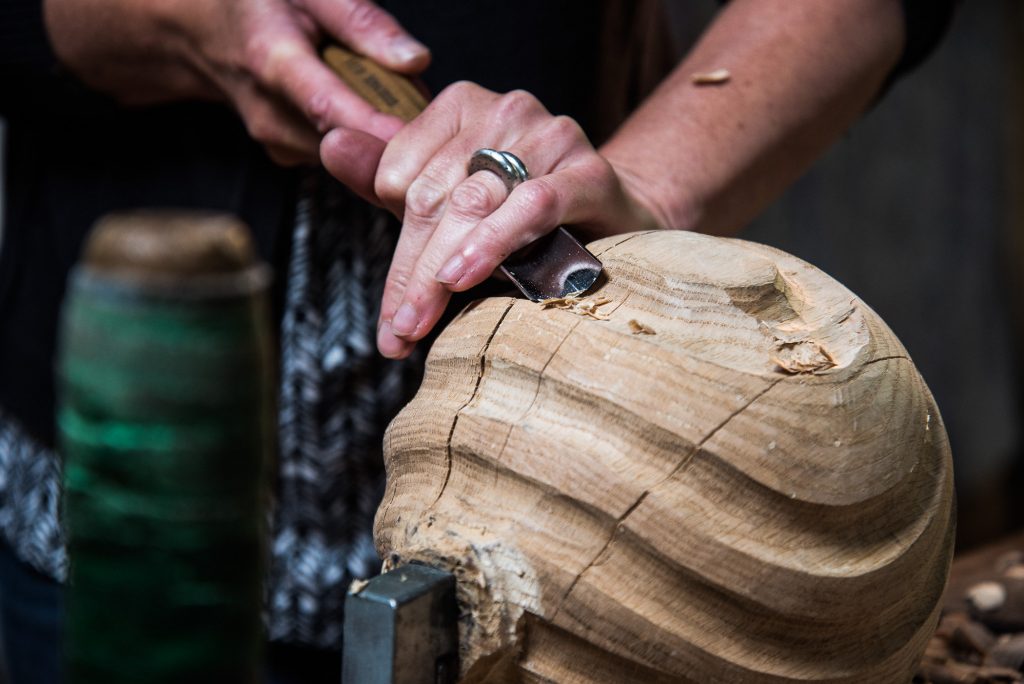
Carving with a small maquette, Photo by Matt Wreford
Why do you specifically use English oak?
It is native, readily available, lasts outside and is loaded with historical relevance – the druids worshipped at alters made of oak, Henry VIII’s tall ships that sailed the globe were built from oak sourced from the same woodlands I select timber from in West Sussex.
You use unseasoned oak; can you explain this for the lay person?
‘Unseasoned’ means fresh or ‘green’ timber, not dried or ‘seasoned’ by air or a kiln.
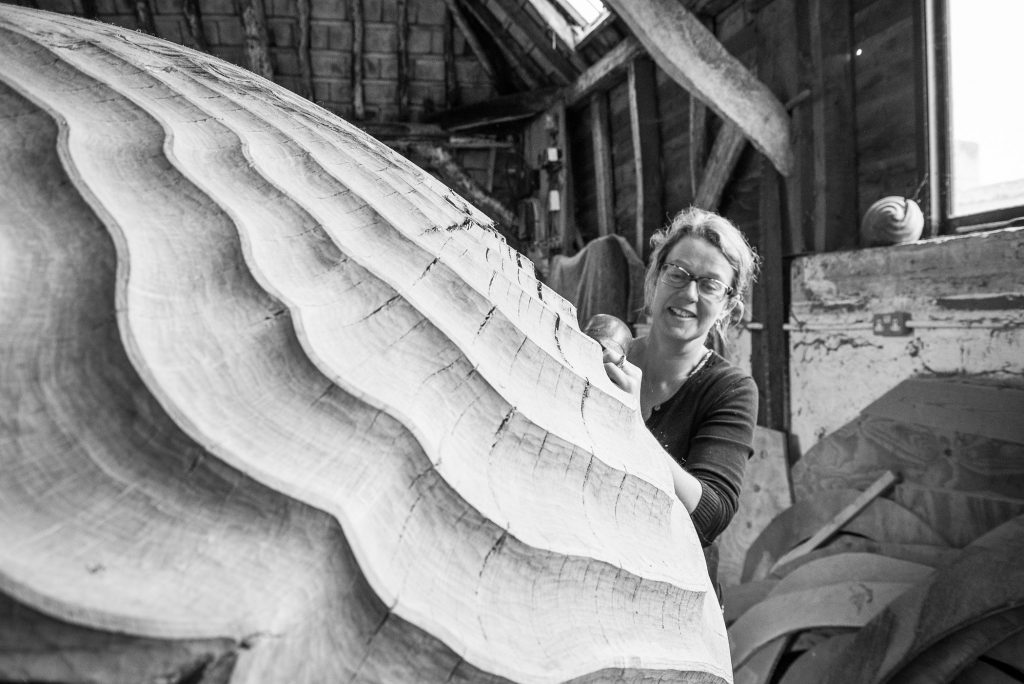
Working in the studio, Photo by Matt Wreford
Your thoughts, on the importance of the correct sourcing of wood and the associated ecological issues?
It is always important to me that the wood I use is sourced sustainably from well-managed woodlands as locally to the studio as possible. We have very high standards of forestry stewardship in the UK which ensures that the timber and woodlands are well cared for.
How does the natural character of the wood influence your work?
I am in conversation with the timber at every stage – from the tree’s habit that can influence the overall shape of a sculpture at the timber selection stage in the woodland, right down to the intricate carving of the finished surface in the studio which may warrant a particular focus around a knot or change in carving direction to accentuate compression ripples under a heavy bough.
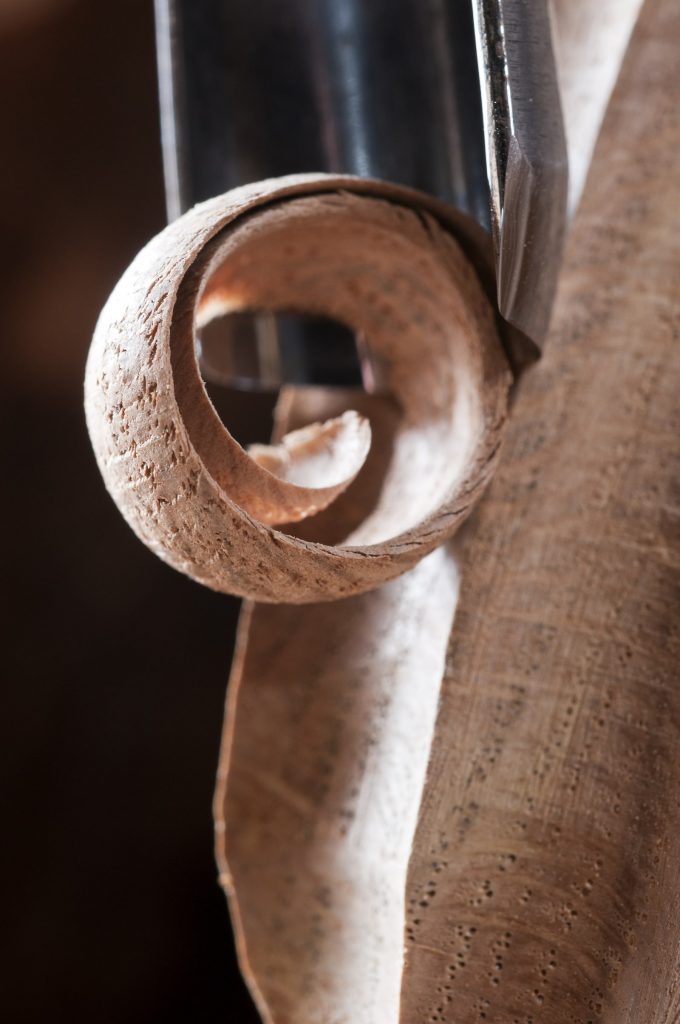
Close up of carving process, Photo by Jacqui Hurst
Take ‘Torpedo’
How you came to have this huge oak to work on and give a new life too?
The tree was offered to me as it had had to be taken down locally because of dropping one of its limbs. It was right on the side of a busy road, the old road to London from Petworth.
How many pieces did it end up being?
The log was 6 metres long and made three sculptures, the ‘Torpedo’ being the largest at 3m long, and two smaller pieces at 1.5m long each – one of which was shipped to a new hotel lobby in Heifei City, China.
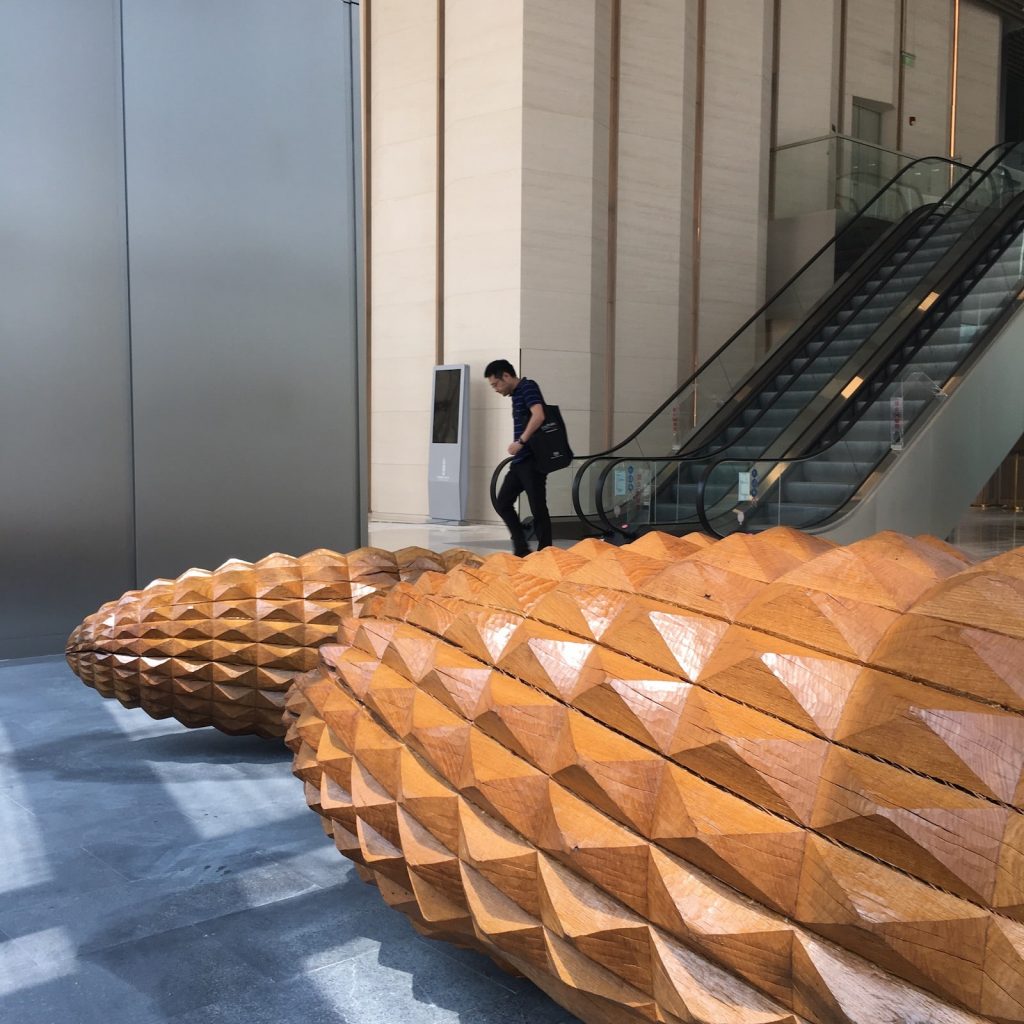 Scale Tree II and III
Scale Tree II and III
It isn’t essential to know the history, but it gives a rich narrative to support the aesthetic appeal. Sometimes clients are particularly interested to know the origins of the tree.
Expand on one of your large installations and why it stands out.
A recent tripartite commission, The Scale Trees, for the main lobby space, Tower 7, One Shenzhen Bay, China, was a joy to produce from the initial concept sketches and research, to the installation in partnership with transport company Mtec and art installers UAP.
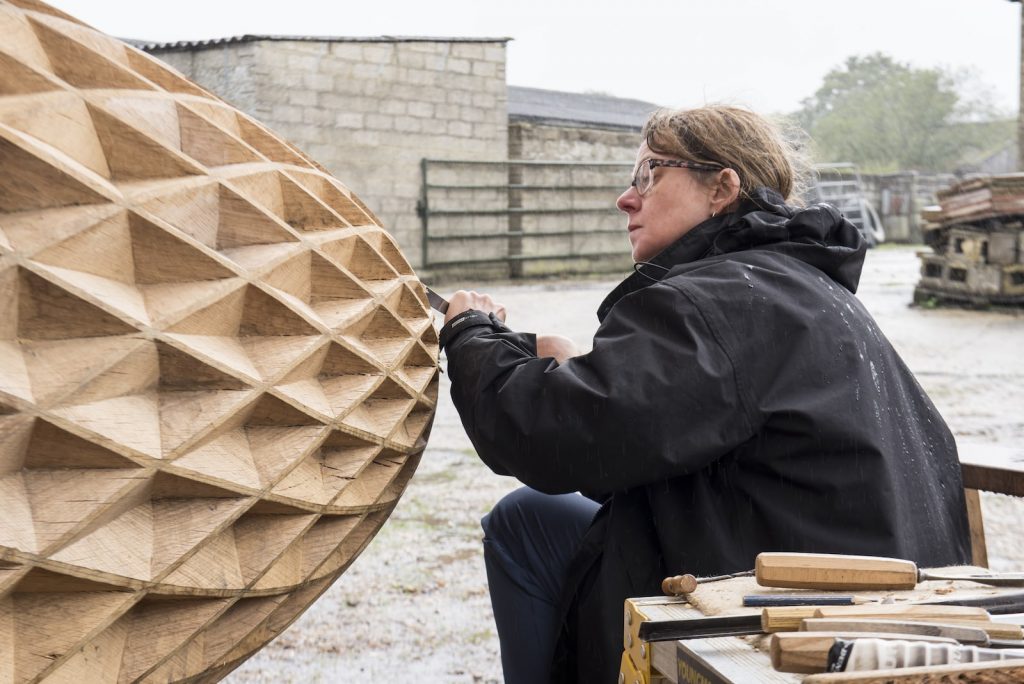
Carving, Scale Tree I
The surface textures of the sculptures were particularly satisfying to carve, they were a new design and involved working with several skilled carpenters here in the UK. Scale Tree I is also the tallest sculpture I have ever made at 5m high.
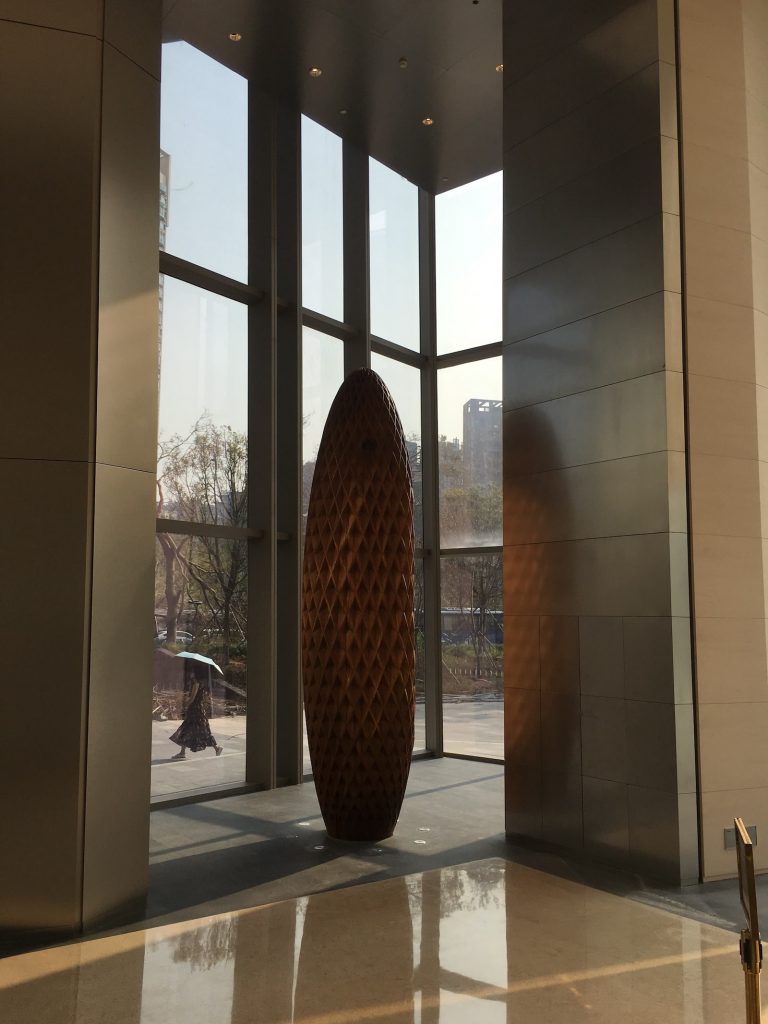 Scale Tree I, Shenzhen Bay, China
Scale Tree I, Shenzhen Bay, China
Scale Tree I, detail.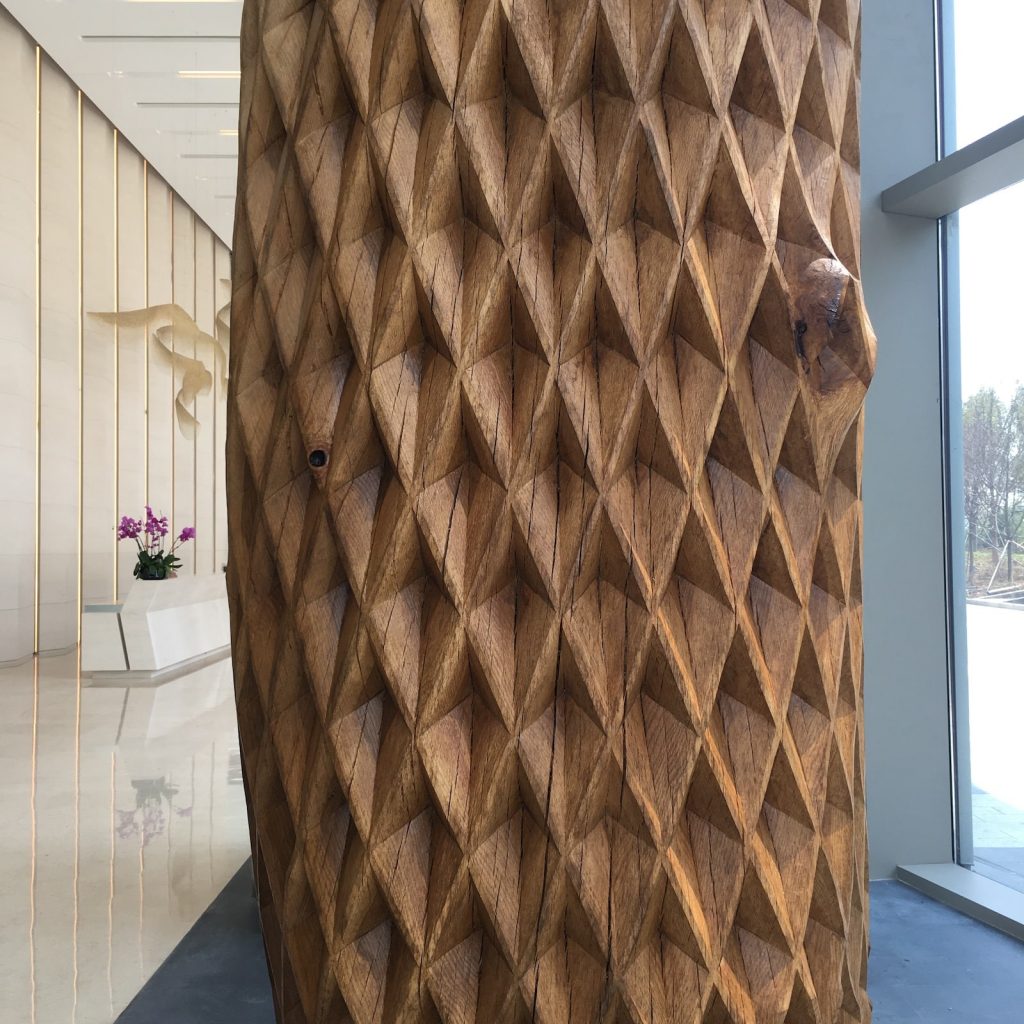 Scale Tree I, detail.
Scale Tree I, detail.
How do you balance exhibition work and commissions?
Good question! I try to factor into the year of commissioned work a couple of ‘gaps’ or opportunities to produce new work that could be exhibited in the future. It’s important to keep developing your work and trying new ideas.
Exhibitions are however a risk financially, I have to be careful that the studio can afford those risks and the commission work takes priority because we have to operate as a viable business.
Can you take us through the process of the “Kissing Bench’
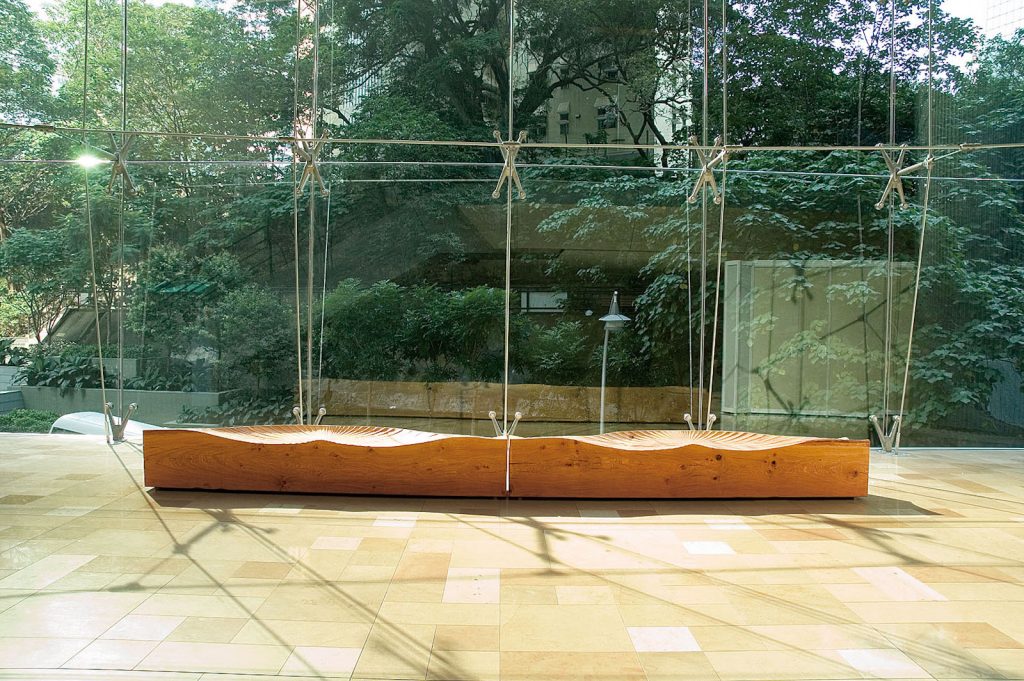
Kissing Bench 11
The original commission:
I was approached in 2006 by an art consultant based in Hong Kong to produce ideas for commissions for a new Swire Properties building, 3 Pacific Place.
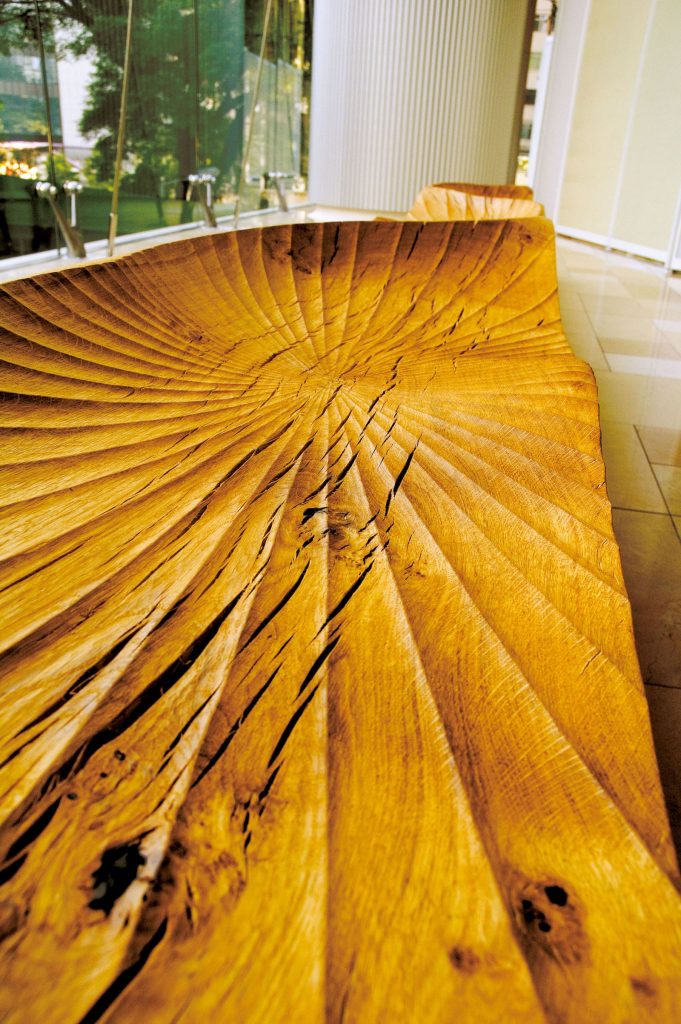
Kissing Bench 11, detail
Design:
The Kissing Bench design evolved from the traditional ‘kissing seats’ where a couple sit together facing in opposite directions enabling them to embrace or ‘kiss’.
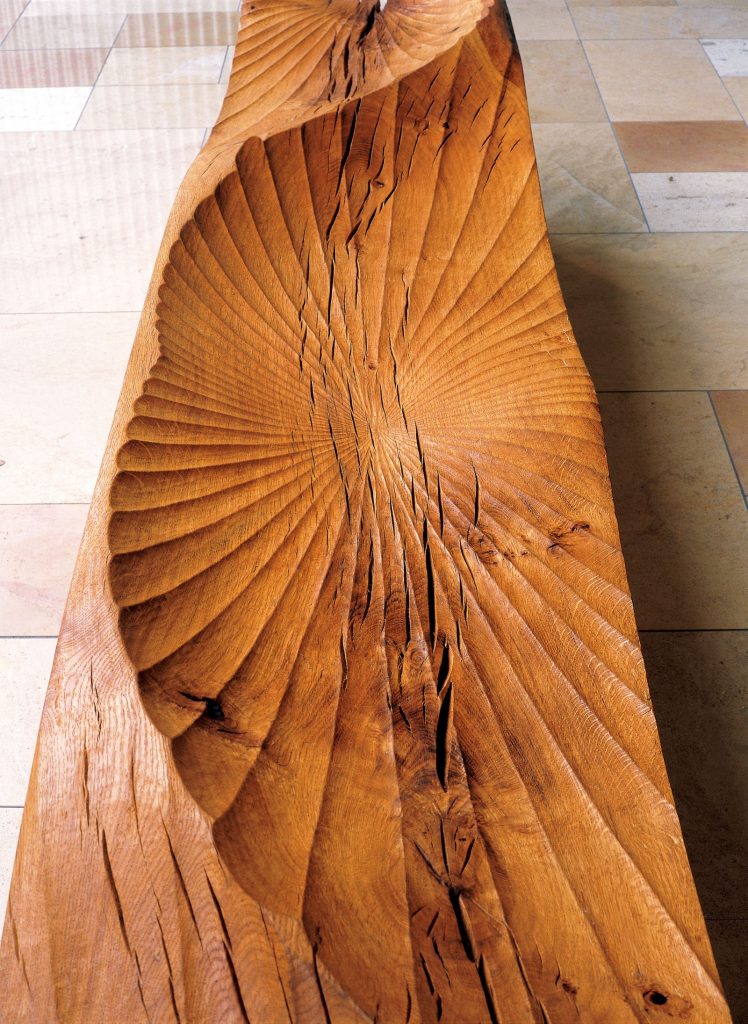 Kissing Bench 11, detail.
Kissing Bench 11, detail.
The process of getting it to Hong Kong:
I organised the shipping myself from the UK to Hong Kong. The art consultant dealt with a local art handler from Hong Kong docks to site.
The sculptures were carefully crated at my studio into wooden crates that were then loaded into a shipping container. The container, after being fumigated, went from Southampton docks to Hong Kong.
Discuss the wear factor of this type of work:
3 Pacific Place is a busy public area with people passing through this space from offices or the shopping malls to the parks, restaurants and cafes, so the benches are in constant use. The seat surfaces have built up a wonderful polished patina from the human interaction, the rubbing of clothing and contact with hands.
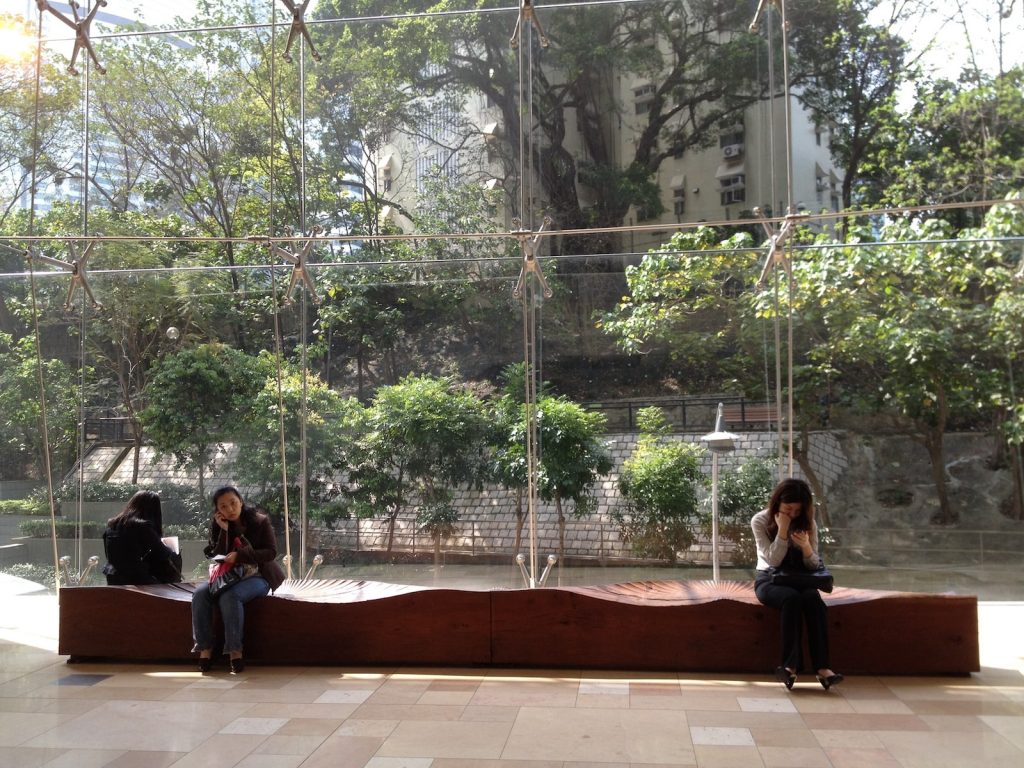
Kissing Bench, Hong Kong
After this a smaller but interesting commission Font 11.
Font II was commissioned for a small boutique hotel in Exeter. The architects were refreshing, keen to have a sculptural ‘reception desk’ to meet and greet rather than acres of polished desk top surface. The flat top needed to be the right height for clients to paperless ‘check-in’ on a tablet. A padded leather circle protects the top and provides a practical surface for signing any papers required.
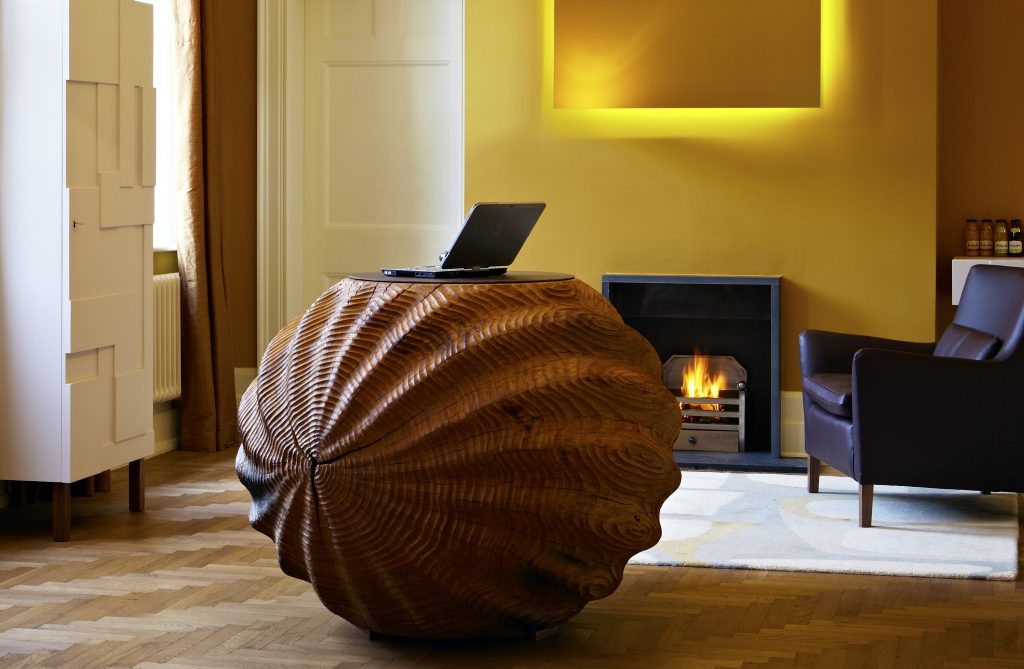
Font II, Magdalen Chapter Hotel, Exeter, UK
Can you take a recent pieces of work that shows your smaller work?
The ‘Walnuts’ are a series of small pieces that I carved last year from English walnut wood that was salvaged from a woodland clearance.
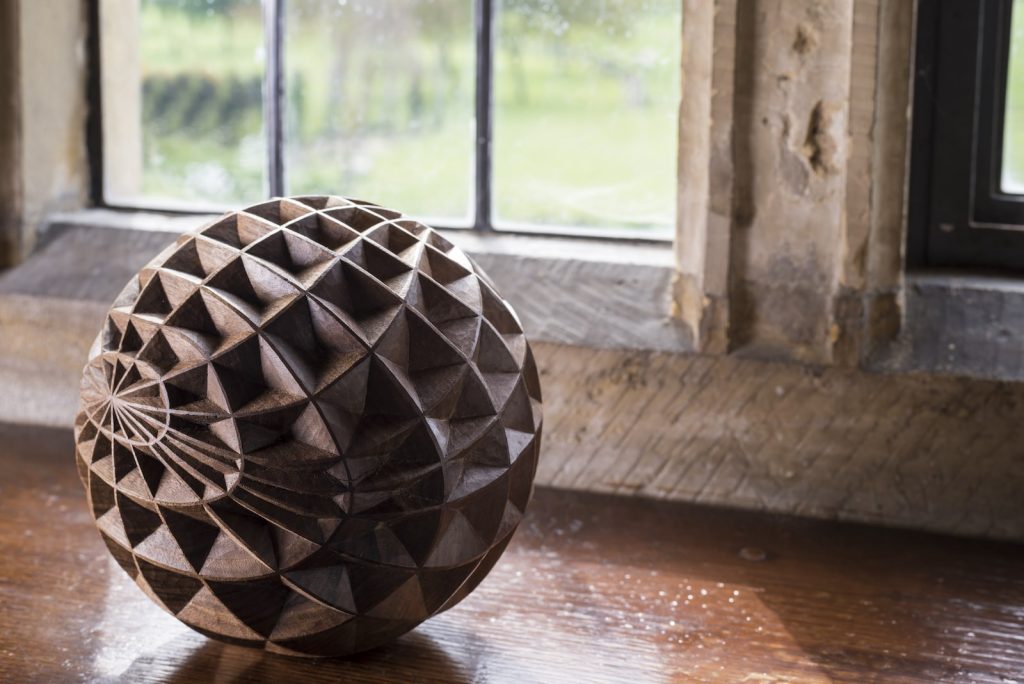
Incised Walnut I, Photo by Jacqui Hurst
The incised texture is intricate and required very sharp gouges to give a precise edge to the geometric patterns.
The lines around the small sphere, although based on a grid, follow the natural annual growth rings one way, almost like latitude on a globe, and the lines going from centre to centre, or pole to pole with longitude, follow the medullary rays, the cellular transport systems that run from top to bottom of a tree.
I’d like to experiment much more with these smaller works.
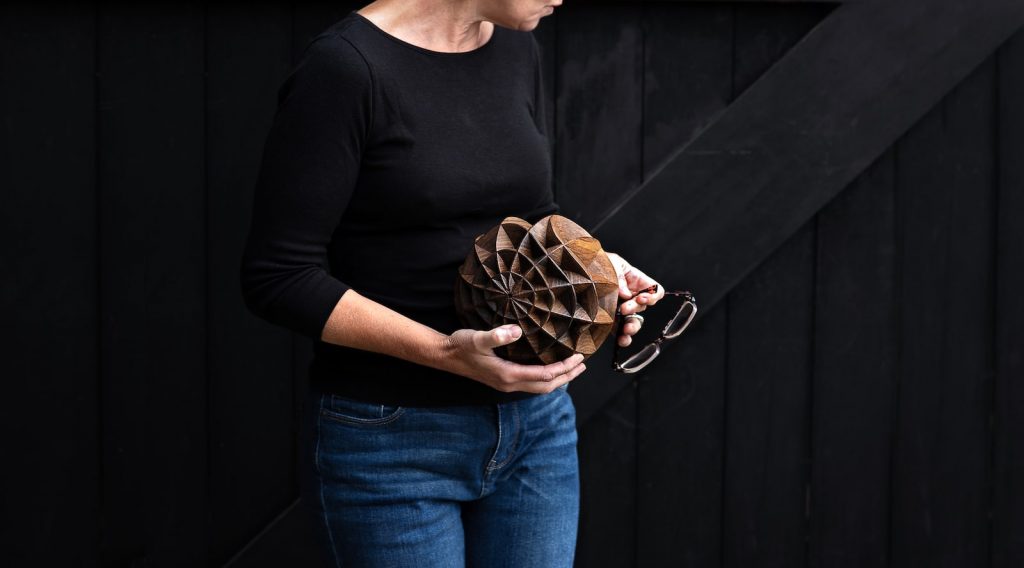 Incised Walnut 11, Photo by Sarah Sheldrake
Incised Walnut 11, Photo by Sarah Sheldrake
Show and discuss one tool that you love using and explain the pleasure it gives you.
Oh! that has, to be my lignum vitae mallet. It’s just so reliable and never needs sharpening!
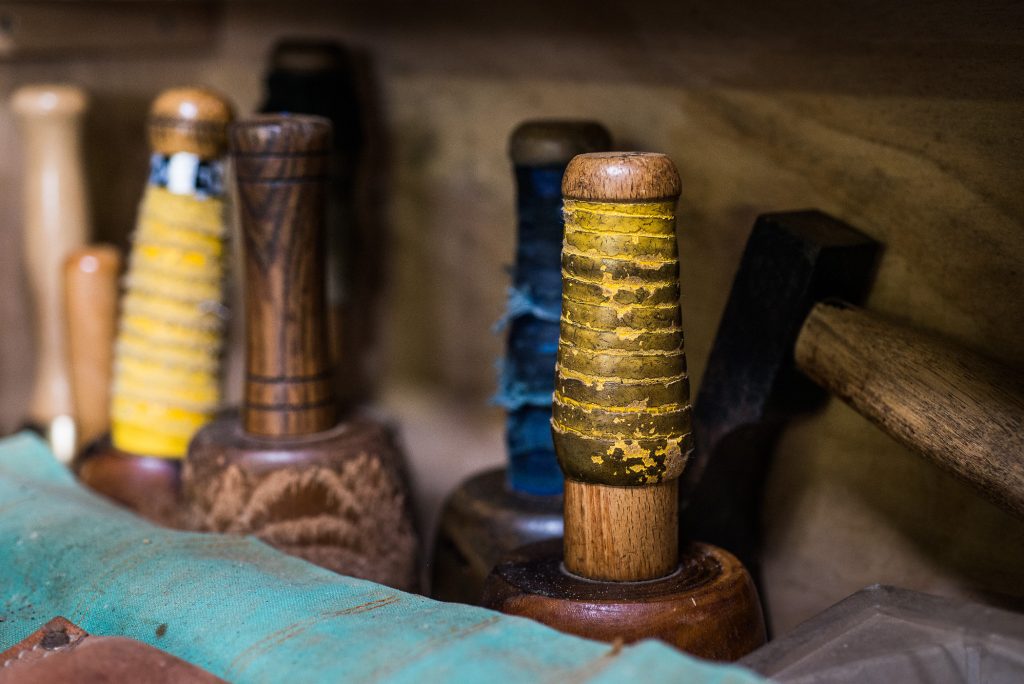
Mallets, Photo by Matt Wreford
You studied at the Royal College of Art, when during this time did you start to work with wood.
That was in my second year at the RCA when the projects became self-initiated. There had been a great storm in the south of the UK and there were hundreds of oak trees that had blown, down so I had access to free materials.
I’m not sure exactly what inspired me to start carving. Perhaps it was a reaction against the high-tech design led environment. Carving is so immediate.
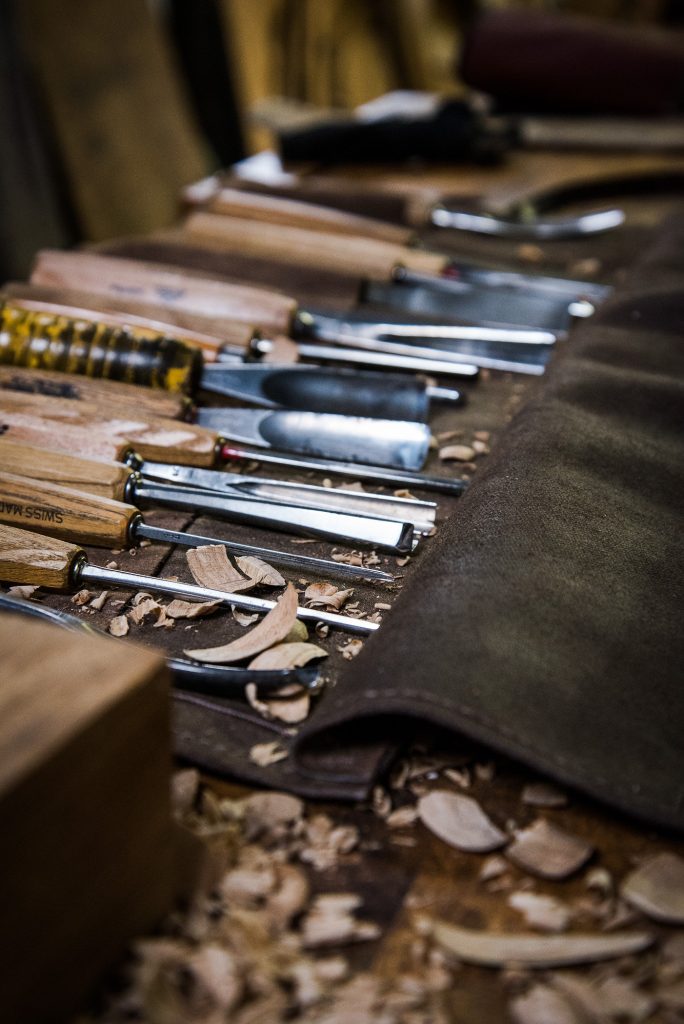 Carving Gourges, Photo by Matt Wreford
Carving Gourges, Photo by Matt Wreford
You are a member of the Royal Society of Sculptors are their many others who work solely in wood?
No I don’t think so. Wood isn’t a very fashionable material for sculpture in the 21st century and direct carving is probably more associated with the 20th century, but I think I bring a fresh way of approaching the material and the processes.
Can we take a peek into your studio and please explain why it is important to you.
I have worked from my current studio, a rented timber-framed barn, on a working farm at the foot of the South Downs for the last fifteen years.
It is about 150m x 2 in size and we use about the same area outside in the yard for storing large sections of timber and doing the roughing-out of new projects.
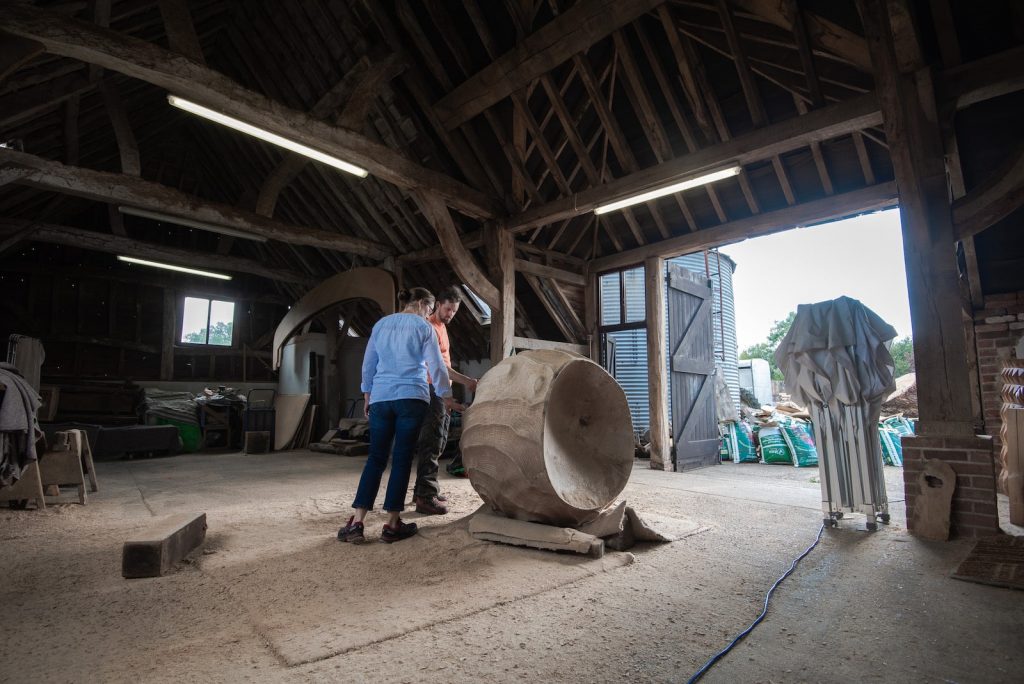
Alison Crowther Studio, Photo by Sarah Sheldrake
The building is timber-framed which dates, back to the 17th century at one end. It is imbued with a sense of history and of being built and crafted, by hand so it feels like an appropriate space to be creating my sculptures in.
Contact details:
Alison Crowther
www.alisoncrowther.com
Alison Crowther, West Sussex, UK
Interview by Deborah Blakeley, March, 2019
Think a colleague or friend could benefit from this interview?
Knowledge is one of the biggest assets in any business. So why not forward this on to your friends and colleagues so they too can start taking advantage of the insightful information the artist has given?
Other artists you may be interested in:


